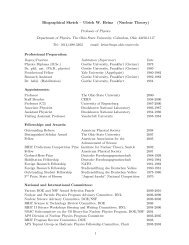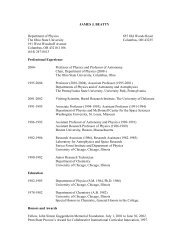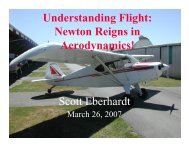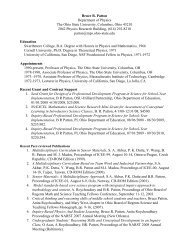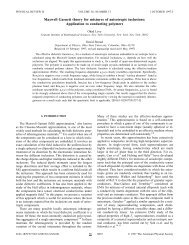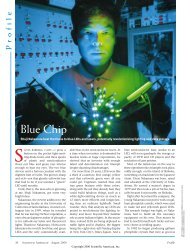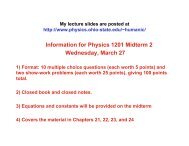Dirac Notation 1 Vectors
Dirac Notation 1 Vectors
Dirac Notation 1 Vectors
Create successful ePaper yourself
Turn your PDF publications into a flip-book with our unique Google optimized e-Paper software.
If |ψ,t〉 is normalized, it follows that<br />
1=〈ψ,t|ψ,t〉 = ∑ ∑<br />
c ∗ m (t)c n(t)〈m|n〉 = ∑<br />
m n<br />
n<br />
|c n (t)| 2 = ∑ n<br />
|c n (0)| 2 . (39)<br />
Note that in the coordinate basis, where ˆx → x ,ˆp →−i¯hd/dx.<br />
〈x|n〉 = u n (x) , (40)<br />
where<br />
[− ¯h2 d 2 ]<br />
2m dx + V (x) u 2 n (x) =E n u n (x) . (41)<br />
Solving this sort of equation for different potentials V (x) (and generaliztions in 3 dimensions)<br />
what we will be doing for the rest of this quarter.<br />
3.4 Comments<br />
Why are these bases we have discussed necessarily different from each other? For example,<br />
can’t we find a basis in which both ˆp and ˆx are simple? No. If we had a state |x, p〉 which<br />
was simultaneously an eigenstate of ˆx (with eigenvalue x) and ˆp (with eigenvalue p) it<br />
would follow that<br />
[ˆx, ˆp] |x, p〉 = ˆxˆp|x, p〉−ˆpˆx|x, p〉<br />
= pˆx|x, p〉−xˆp|x, p〉<br />
= (px − xp)|x, p〉 = 0 (42)<br />
since x and p are ordinary numbers, and commute both with each other and with operators<br />
ˆp and ˆx. But we know that<br />
[ˆx, ˆp] =i¯hˆ1 (43)<br />
(we don’t normally write the ˆ1) which is inconsistent with the previous result, and so there<br />
cannot be such as state as |x, p〉.<br />
The result is that a state |ψ〉 cannot simultaneously be an eigenstate of two<br />
operators that do not commute.<br />
For the hydrogen atom, we will find that we can find basis sates which are simultaneously<br />
eigenstates of Ĥ, ˆL · ˆL, and ˆL z , where L refers to the angular momentum vector. We will<br />
discuss a normalized basis of angular momentum states later in the course.<br />
7





